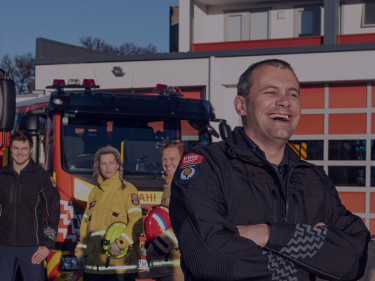The Beachlands Volunteer Fire Brigade
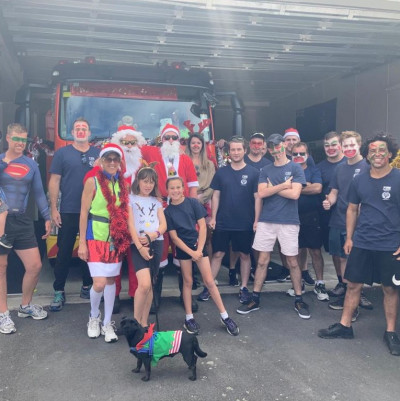
Nestled at the end of a winding road of greenery sits Auckland’s coastal suburb of Beachlands. This tight-knit community is watched over by group of locals with an even closer bond – the Beachlands Volunteer Fire Brigade.
“We’re in this together, we’re here to serve – and we love it,” says volunteer firefighter Richy Morrison.
The 29 dedicated volunteers in the Beachlands brigade take pride in the work they do for their community.
“They understand that teamwork doesn’t just happen within the brigade, it extends to the wider community. They play a crucial role in education and risk reduction – they want to keep their community safe,” Group Manager Phil Larcombe says.
The Beachlands brigade spreads fire safety messaging to locals by attending marathons, Christmas parades and organising the infamous ‘Santa lolly run’.
“Every Christmas we drive the fire truck around town and hand out lollies to the kids. It’s a great way to get our faces out there, educate, and hopefully inspire the younger generation,” says volunteer firefighter and arborist Phil Jessep.
The desire to inspire runs through the brigade. Born-and-bred Beachlands local, Richy Morrison wants to inspire the local kids, just as the firefighters inspired him when he was a boy.
“Firefighters came to my school and I got to hop in the truck and try on the uniform. I’ve wanted to be a firefighter ever since – and now I’m living that dream,” says Richy.
Senior Volunteer Firefighter and ex-pastor Neil Hamilton first witnessed the brigade’s impact on the community when the previous fire chief, who had asked Neil to conduct his funeral, sadly passed away.
“The respect that was paid to him that day was impressive as he was such a significant part of everyone’s lives. That day I felt such a strong sense of community, camaraderie, and support in Beachlands – and that’s why I wanted to join.
“Helping others is why we do it – you just have to have a passion for helping people,” Neil says.
“We really can’t do this without one another. We trust each other with our lives as much as the community trusts us with theirs,” says Richy.
“We can’t stop bad things from happening, but we can make people’s lives a little bit better,” says Neil.
There’s no doubt the Beachlands Volunteer Brigade are making the lives in their community better – one lolly at a time.
Te Anau Volunteer Fire Brigade
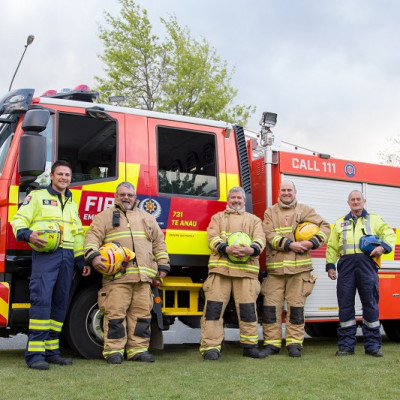
Photo credit: Mel Remnant
Graeme “Possum” Moffat has been a volunteer firefighter for over 30 years. He is Chief Fire Officer for Te Anau Volunteer Fire Brigade. The Brigade has 25 volunteer firefighters, and three volunteer operational support personnel, ranging in age from 17 to 68 years.
“They’re a great team, always working together, bouncing ideas off each other both at training and on the job, and they always have each other’s backs whatever the situation,” Possum says.
This is reinforced by the tenure of volunteers at the Brigade, with a number receiving their gold star service (25 years of service).
Possum values the team he has, not only for the great job they do as volunteer firefighters but also for how they’re always pitching in for the community.
“If there’s a food drive for the local food bank, the team is right behind it, doing whatever they can to support the community.”
In 2018 Possum came up with the idea of supporting firefighters who need some time out from their day to day lives. This might be due to ill health, trauma from incidents experienced as a firefighter, or just the stresses of day to day life.
Fire and Emergency provides a range of free and confidential support services which can be used for personal or work- related matters. Services include counselling, professional psychological support, peer support, dedicated safety health and wellbeing advisors, a health monitoring programme, chaplaincy, and tikanga Māori-based services.
But Possum wanted an additional service to be run independently and in beautiful Te Anau.
He raised the concept at a brigade meeting and received full support from the team, which lead to the creation of ‘K10 Te Anau’. In firefighter radio speak, K10 means ‘to recommission, to get ready for the next call’, so it is the ideal name for the initiative.
Nominated firefighters and personnel are provided with an all-expenses paid trip to Te Anau, with the two to three- day break tailored specifically to them.
The Fiordland community has also got behind the initiative, helping to fundraise or donating accommodation, meals, or tourist activities which means every trip has been one to remember.
This is something that Possum treasures, “it has extended the camaraderie from not just amongst the Brigade, but across the District as a whole.”
The teamwork of this Brigade means they’re not only looking after their community, but they’re helping to look out for fellow firefighters from across Aotearoa.
Feilding and Manawatu Volunteer Fire Brigades
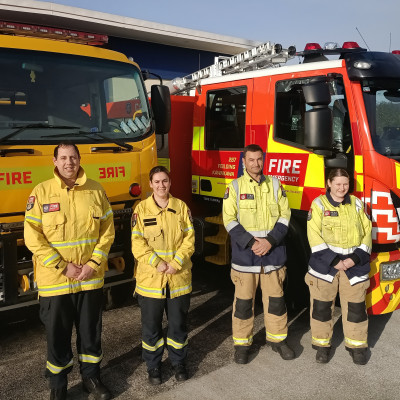
The Feilding and Manawatu Volunteer Fire Brigades work in a way only a few other brigades do in New Zealand. Since 2017 they have been co-located at the Feilding Fire Station. Manawatu specialises in wildfires and Feilding in structural fires. Between the two brigades, they attend around 400 callouts each year.
In February this year, Feilding was hit by some heavy rain which caused localised flooding around the town. Both brigades have their own skills and abilities, which their leaders were able to utilise during the incident.
“During the flooding the two brigades were really able to complement each other. We could take our four-wheel drive vehicles out to places that Feilding wasn’t able to because of the flooding,” says Rural Controller Nick West.
“Manawatu has better pumping gear than we do, so during the flood, we were able to work together more efficiently,” says Chief Fire Officer Bradley Shanks.
“Everyone pitched in where they could during the flood. Not everyone can get away from work, or their families for the whole time, so we took shifts over the two days.”
“It’s the little things that mean the most during the long incidents,” says Manawatu volunteer firefighter Lucy Robson. “Even just a text saying, ‘hey do you need dinner?’ it means that everyone can help the team in their own way.”
The opportunity for the two teams to share a station was something both brigades have made the most of.
Nick West says they were lucky Fielding is such a large station with room for everyone.
“Feilding was super welcoming and the co-location was a very smooth process,” he says.
“Since the co-location both management teams have worked quite closely. We’ve formed a leadership committee so everything’s humming together.”
Bradley Shanks says it made sense to share a station since Manawatu and Fielding both had a common goal and direction.
“It feels like a family, everyone’s there to support one another, we all work really well together. Especially coming in as a newbie it was super welcoming,” says Lucy
There are seven people that volunteer for both brigades, which the brigade leaders say is a compliment to both teams.
“It helps that we’ve got members in both brigades. It means that things get together a lot better between the two brigades and our own teams.
“Our team is great, because even though it’s 43 different personalities, it means that there’s 43 different ways of approaching something,” says Bradley.
Manawatu and Feilding have embraced their co-location, to support what matters most to both brigades; protecting their community.
Minginui Volunteer Fire Brigade

Community and family. That’s at the heart of the Minginui Volunteer Fire Brigade.
The station is located in a remote area of the Whakatāne District, and in 2015, it closed and the truck was driven away due to a lack of volunteers to staff it.
But after a push in 2018, led by Te Runanga O Ngati Whare trustee Bronco Carson, Minginui Station was reopened and 18 volunteers answered the call.
One of them was rural firefighter Vale Ruri, who was initially reluctant to join. Her parents had been volunteers at the station, which has records back to 1951, and she eventually decided she simply had to join to help her community.
“We’re a remote and isolated area. We were watching a lot of things happen. A lot of our houses were burning down. People were having heart attacks.
“We had to do something for our community. We had relied on our parents to do it, but you forgot that they were getting older. Our generation had to step up.”
About 1300 people live in the area near the station, with just an estimated 300 in the village itself.
The brigade still has 18 members in Minginui and, after it was identified Ruatahuna, about an hour’s drive away, also needed support, nine more members qualified as rural firefighters for a satellite station. Another nine are in the process of qualifying.
Rural Controller Brent Boggs says the stations have become community hubs in both villages.
“When you come in here it’s a positive thing only. We have baby showers, birthdays, fundraisers, all that stuff.
“This place needed it.”
Vale says the brigade is a close-knit group.
“The camaraderie is really strong. We are really tight. As soon as we open that door, we are 100% behind each other.”
Wellington Operational Support Unit
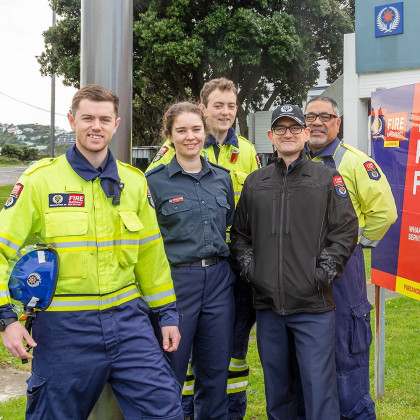
Based in the Kilbirnie station, Wellington Operational Support Unit is a far cry from its humble beginnings in 1899. They used to be the Wellington Volunteer Fire Police, providing an essential service alongside Wellington’s Municipal Fire Brigade. Their duties included assisting firefighting, performing salvage to protect property and securing scenes. They even had the powers to arrest back in those days.
In 1995 the Unit was formally integrated into the then New Zealand Fire Service and since then, has evolved its duties to include incident ground logistics, scene lighting, traffic management as well as victim and evacuation support.
Senior Station Officer Jono Ashman, the Unit’s current Officer in Charge, is proud to contribute to the long history of volunteer support in Wellington.
Jono took over as the OIC in 2016 only two years after joining as a volunteer. As can happen with volunteer brigades, Wellington Operational Support Unit had struggled to maintain a full establishment of volunteers. When Jono was appointed the Unit only had five active members, however through a lot of relationship building with career staff and the community, the membership rose to a healthy 25 within three years.
Late on a stormy Monday night in July 2021 the Unit were asked to provide scene lighting and protection for people looking after Toa. Toa, a juvenile Orca, had been separated from his pod near Plimmerton Boating Club.
“After spending most of the night there we were then tasked with rostering multiple volunteers over 11 cold days and nights to manage traffic, pump sea water, organise donated resources and monitor cordons. Our brigade members alone spent over 120 hrs on scene and many more hours on the phone organising the response.
“It was an amazing to be involved in a concerted effort to save Toa. People from multiple agencies and communities came together to keep Toa alive until he could be repatriated with his pod. Unfortunately, Toa passed away on July 23. Even though the outcome wasn’t what we all hoped for we were proud that we did as much as we could to save Toa,” says Jono.
Life’s pressures mean that volunteers continually come and go but the Unit’s emphasis on teamwork has helped form a strong inclusive culture.
Jono enjoys working alongside and supporting the wider Fire and Emergency NZ team to help the community prevent, prepare, respond and recover from emergencies. He says the Unit’s mantra is “We are all stronger when we work together.”
Culverden Volunteer Fire Brigade
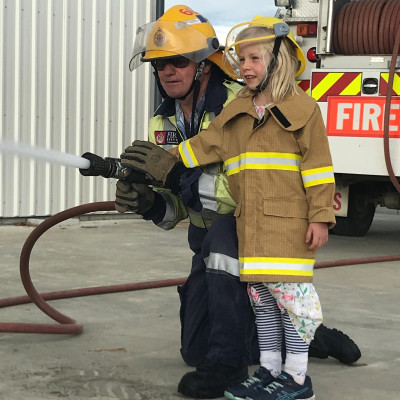 The Culverden Volunteer Fire Brigade works together as a team to help protect their community. The brigade is lead by Chief Fire Officer Craig Ritchie who has been with the brigade for 22 years.
The Culverden Volunteer Fire Brigade works together as a team to help protect their community. The brigade is lead by Chief Fire Officer Craig Ritchie who has been with the brigade for 22 years.
“I never thought about joining the brigade until I got asked to join. Once I got involved, I really enjoyed it. Volunteering is challenging, and it’s great being in the company of other like-minded people, it means our team gels together really well,” says Craig.
As the Chief Fire Officer Craig finds it rewarding seeing his team members grow into their roles at training and at incidents.
“One of my favourite things about working alongside our team is watching their development. Its great to see everyone’s skills develop and to see them take on the different challenges and taking on leadership roles.
“A new transfer that was at training the other night texted me: Hey, Craig there is a really cool family environment within the brigade. It stands out.” says Craig
The brigade responds to a range of incidents, in the area and Craig says they wouldn’t be able to do it as well if they weren’t such a tight knit team.
“You can’t respond to an incident by yourself, we have to respond to an incident as a team and work together as a team. We’re all trying to make a difference in someone’s life, and we can only do that as a team.”
Responding to incidents isn’t the only way the Culverden Volunteer Fire Brigade is trying to keep their community safe. They’re also trying to help their community by giving them the earliest warning of a fire through installing smoke alarms. They are also working with farmers to increase the visibility of their RAPID numbers.
“One night instead of training, we went door to door quickly and checked smoke alarms throughout the village.
“It’s about doing whatever we can to make our community safer, says Craig.













